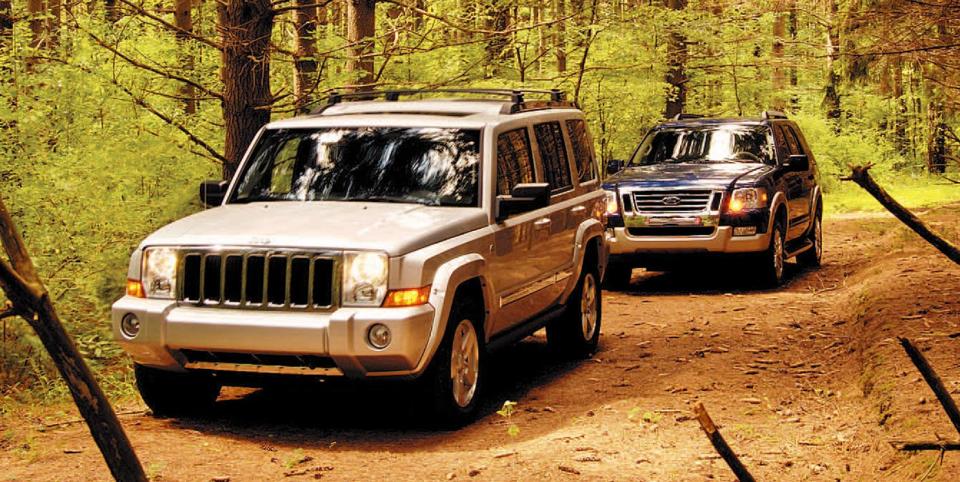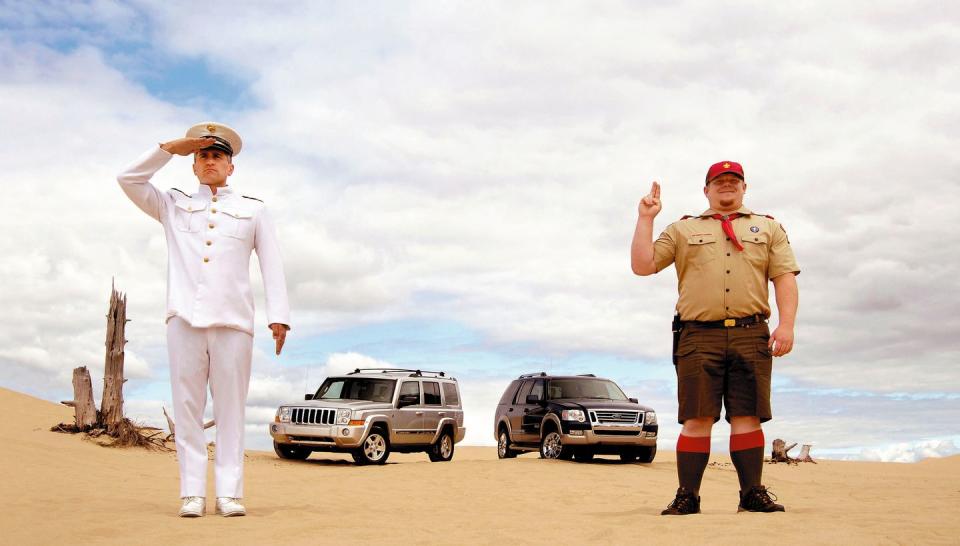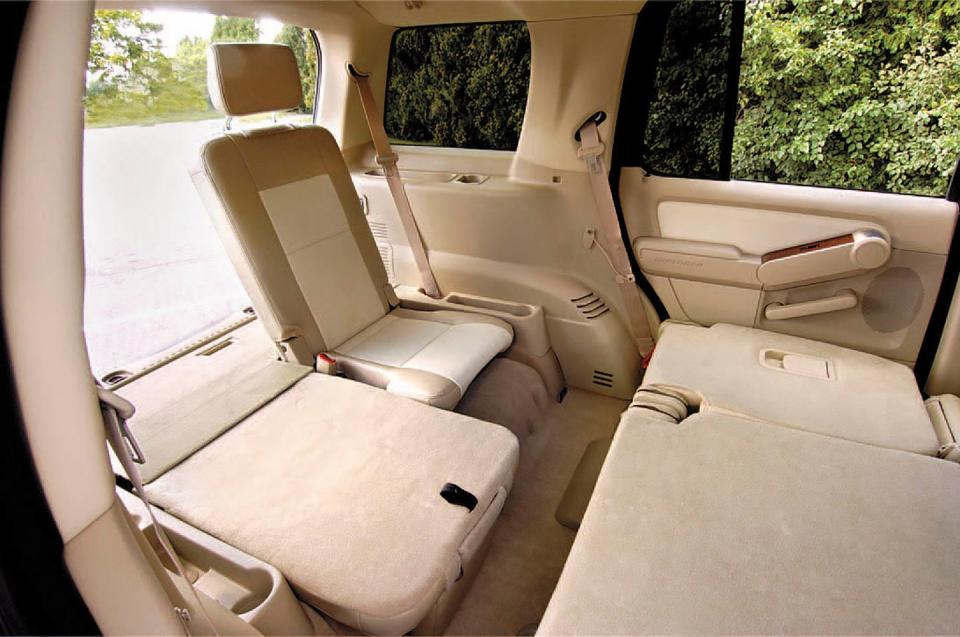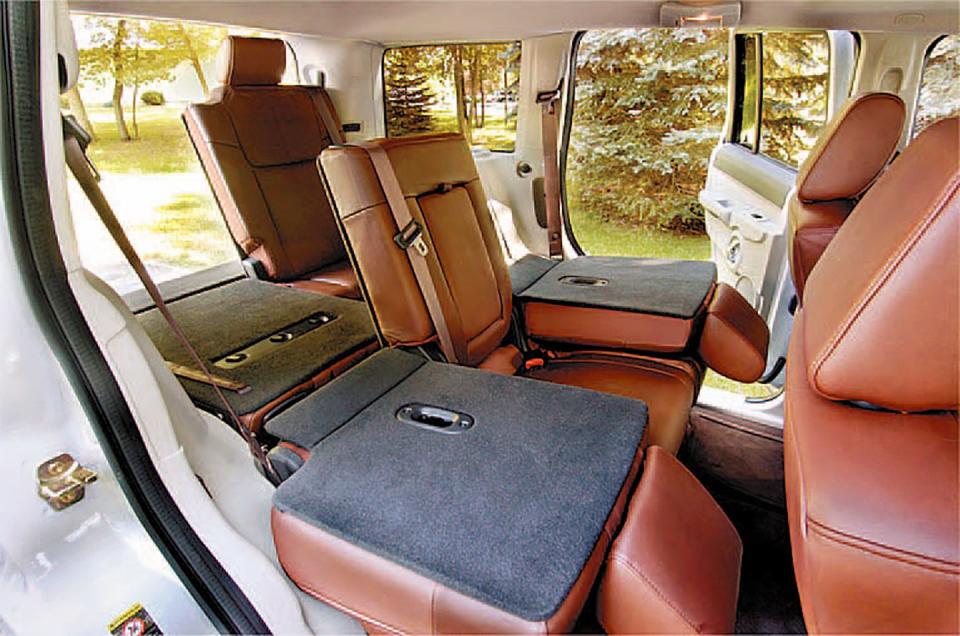Tested: 2006 Ford Explorer vs. 2006 Jeep Commander

From the November 2005 issue of Car and Driver.
It was only last April, in a C/D comparison test dubbed "Destination: Chicken Point," that we sampled six size-M SUVs. Since then, two newcomers have alighted. Well, not newcomers exactly. More like face-lifted Hollywood agents just back from a trying month at Betty Ford.
In fact, one is a Ford, the comprehensively reworked Explorer, notable not for its styling—again a say-nothing ode to suburban blandness—but for its six-speed automatic and 292-hp, 24-valve V-8, the Mustang GT's engine.
The other new and decidedly angular face is that attached to the Jeep Commander. You may not know the Commander's name, but you know the Commander's dad. What we have here is a made-over Grand Cherokee, with which the Commander shares its driveline and wheelbase. This new model—an adjunct to the line, not a replacement for the Grand Cherokee—adds 1.9 inches of length and 4.2 inches of height, allowing it to become the first Jeep in history with three rows of seats, an increasingly mandatory sales tool in the segment. And the blocky styling? Well, the Jeep guys say they've rarely had a group of buyers more devoted than those who owned 1984-to-2001 Cherokees, thus the familiarly retro nose and refrigerator-like silhouette. Which makes you wonder why the Commander's rump resembles a Hummer's.

In our "Chicken Point" comparo, the Explorer finished an embarrassing sixth among six, mostly because it was then in its fourth year without a major freshening. But in the same test, the Grand Cherokee—again, the vehicle on which the Commander is based—finished first. Clearly, these two newcomers deserved their own middleweight rumble. But instead of reexamining all the major players so soon, we opted for a more efficient two-ute arm-wrasslin' and sand-slingin' bout in the horsefly-infested wilds of Michigan. Which, in C/D-speak, means we again wound up at the Silver Lake Sand Dunes, searching for fulgurites, which aren't prohibitionist missionaries but are, instead, tubes of glass formed when lightning strikes the sand. Thing is, if lightning struck here anytime in August, it would first melt the helmet atop a sweaty human head. That's because all 2000 sandy acres are seasonally aswarm with whooshing motorcycles, buggies, ATVs—and SUVs, whose hard tires and colossal heft make them as suitable to duning as Michael Jackson is suitable to babysitting.
For no good reason—well, some beer may have been involved—we brought along human representations of the vehicular contretemps to follow. Representing the Ford Explorer was Explorer Scout Billy "'Bama" Banjo, a hefty and solid young man who came equipped with bowie knife, Scout-approved ropes, and an apparently inexhaustible supply of teriyaki beef jerky. Representing the Jeep Commander was Commander "Mad Brad" Lavender—fit, trim, impeccably starched, and clearly annoyed to be in the company of juveniles, not so much Explorer Billy as, uh, us. Scoff if you will at their eccentric struggles, but rest assured that Messrs. Banjo and Lavender fought heroically and Homerically, both emerging with slightly chewed ears.
Second Place: Ford Explorer

For 15 years, the Explorer has been the top-selling mid-size SUV in America. Sell 5.5 million of anything—tortillas, chicken elbows, nuclear-powered eggbeaters—and you tend to cling fiercely to the original blend of herbs and spices: same body-on-frame construction, same risk-free styling, same Everyman approach to sport-uting. Blindfold the owner of a '91 Explorer, set him in the driver's chair of this gen-four edition, and he'd still exclaim, "Hey, it's an Explorer!" Then, of course, he'd crash.
What you notice first about the Explorer is its much-reduced levels of NVH, thanks to new driveshafts, butyl body mounts, and more effective sound-thwarting goo. It's so serene that you can hear the tread blocks of the Michelins squirming in turns. At idle, at full whack, and at a 70-mph cruise, the Explorer proved less vocal than our Commander, a blessing on the boring freeway slog to the dunes.
The Explorer's cargo capacity and rear seating also proved superior. The Ford is 0.9 inch taller and 4.9 inches longer than the Jeep, thus able to haul more cases of beer. More important, those few inches rewarded three adults in the second row—their hips weren't touching, shoulder room was ample, and our six-footers never mussed their coifs. Even the usually tedious flip-and-fold routine, necessary to gain access to the third row, was deemed sufficiently simple for fourth-graders, which is why we could get back there. So how come the front-seat footwells are so narrow, forcing legs against the tunnel and inner door panels? How could this happen in any vehicle weighing 5059 pounds?

Perhaps it goes without saying, but 53 newfound horses make an obvious and gratifying difference. The Explorer now scoots to 60 mph 0.4 second sooner than its predecessor and does so with less chatter and roar. Even so, step-off remains gentle—far more predictable than the Commander's. Just don't go boasting to your neighbors about your hot-rod ride: Top speed has been governed to 98 mph.
The Explorer is fitted with avant-garde interior door handles and grab bars—the former too far forward, the latter too low. After five days of uting, we still had to look to find them. The bottom of the gas pedal is too far from the floor, shedding the driver's foot. The liftgate requires a major effort to slam. The chrome trim rings surrounding the air vents and gauges—in what is otherwise a bright and attractive dashboard—cast nasty reflections in the windshield. No driver felt perfectly in sync with the relationship among seat cushion, steering wheel, and pedals. And no vehicle costing $43,860 should ever ride atop wheels covered in plastic.
Ford's new six-speed automatic proved useful—for one thing, observed fuel economy climbed by 2 mpg—and we soon learned to summon one-gear kickdowns when two were unnecessary. But those kickdowns were accompanied by an unseemly wait. Powering out of tight turns became an exercise in prophesying.
On our handling loop, the Explorer always felt tall and tippy. It wasn't, actually, but the perception was enhanced by an aggressive stability-control system that kept reminding the driver he'd exceeded Dearborn's predetermined limits of festive roll and yaw.

We humped the Explorer through some mild off-roading routines—mild because this SUV came with no skid plates. The Ford didn't quite demonstrate the lusty climbing genes of the Jeep, in part because it didn't possess the Hemi's low-down grunt. But the Explorer's cushy ride and rigid, rattle-free platform made its cabin a far, far more agreeable locale when the roads vanished. Lateral head toss, in particular, was virtually nonexistent. In fact, the Explorer's ride surpassed the Commander's on every surface we sampled, a happy side effect of its nontaxing independent rear suspension.
Add to the Explorer's many upgrades its revised steering—a little lighter, more linear, and more disciplined about tracking, especially in crosswinds—and this bumper-to-bumper remake deserves applause. Still, whenever you're driving the Explorer, you're ever aware it's a truck—a refined truck, but still a truck. Nowhere is this more evident than in traffic, where it is a smidgen slow-witted and awkward. In all other respects, this SUV evinces a perplexing characterlessness. It's like trying to coax Al Gore to recall his first sexual caper. There may be a zesty story lurking within, but your chances of unearthing it are slim.
2006 Ford Explorer Eddie Bauer 4x4
292-hp V-8, 6-speed automatic, 5059 lb
Base/as-tested price: $34,270/$43,860
C/D TEST RESULTS
60 mph: 7.8 sec
1/4 mile: 16.2 @ 86 mph
Braking, 70–0 mph: 194 ft
Roadholding, 300-ft-dia skidpad: 0.71 g
C/D observed fuel economy: 16 mpg
First Place: Jeep Commander Limited 4x4

All the Jeep Grand Cherokee's most cherished traits—among them its hale 330-horse Hemi—are accurately reflected in the Commander. Plus, the Commander offers 16 exposed allen screws on the dash and 20 more on the fender flares. Manly, dude.
Fact is, the Commander is 38 horsepower manlier than the Explorer, and those ponies begin stampeding at lower revs—which bestows the Jeep with a 0.5-second edge in the zero-to-60 dash. That also makes the Commander 0.9 second quicker than the average size-M ute in our April comparo. The downside is slightly jarring step-off and observed fuel economy of—whoa!—13 mpg. Stupid, dude. Marry a fat lady and you gotta buy her groceries.
The Commander instantly earned points for its wide and roomy front seats, its control relationships, and its agreeable arms-out driving position. The front footwells proved more spacious, too. Then it lost points for its constricted third-row seat. The uneven floor made it tricky to climb back there, and "climb" is the correct descriptor. Third-rowers sit with their heads jammed into the 3.2-inch step in the roof, and their view of passing scenery is scant. Come to think of it, the driver's view isn't so vast, either, limited by the stubby, upright windshield. Retro design comes at a price.
The Commander's steering is a hair too lazy off-center and more or less numb thereafter. Truth is, neither of these trucks offers anything like true road feel. On the ballot to rank steering, one editor eschewed numbers and simply wrote, "Some."

But there were pleasant surprises, too. The Commander offered a real hand brake, for instance, just starboard of the driver's right thigh, where God and Petter Solberg intended. The ignition switch was in an obvious location on the dash, not hidden on the steering column. And the brake pedal proffered carlike feel, with no dead travel.
The Jeep's five-speed automatic was quicker to kick down and generally less busy than the Ford's six-speed. But, hey, when you have this much power, who needs gears? Moreover, the Commander comes with a slap-happy manumatic: Tip left for downshifts, right for upshifts, and all those shifts materialized sooner than the Explorer's.
Off-road, the unibody Commander proved an eager climber, mostly by dint of 375 pound-feet of "git 'er done." But its chassis evinced an unseemly number of shivers, wonks, clomps, and grunts as the suspension worked through its considerable travel. The Commander always complained that it was working harder than it was—including plenty of pushrod engine roar—while the Explorer just kept its mouth shut.

Overall, the Commander felt more connected to terra firma and was slightly more gratifying to drive than the Explorer—a little like saying one of the Bush twins parties slightly less than the other. And the Jeep at least made an attempt, however pale and old-fashioned, at distinguishing itself stylistically. But it sure is a big ol' dog—5263 pounds and 21 inches longer than the extinct Cherokee it so earnestly hopes to mimic. If you're searching for the sensitive, agile responses of, say, the car-based SUVs—the Toyota Highlander and the Honda Pilot come fleetingly to mind—you won't find 'em here. Of course, those "Miller Lite" SUVs can't tow 7200 pounds, as can the Commander, nor do they feel as unbreakable in the dirt.
Unless you're conducting some "difficulty eight" off-roading, neither of these SUVs is much fun. If your goal is simply to seat seven, buy a minivan. A Honda Odyssey is quicker to 60 mph than the Explorer, has a higher top speed than either of these SUVs, is quieter at idle, offers better fuel economy, outgrips both, is faster through our lane change, includes steering with actual feel, affords easier access to the third seat, will carry more than two fulgurites when the rearmost seat is raised, and will tow 3500 pounds—sufficient for any of the ATVs, motorbikes, buggies, or two-person campers we encountered at the dunes. Did we mention that minivans are cheaper?
Buying an Explorer or Commander on the premise that you might, one day, need to carry seven persons and tow a Bayliner up to Chicken Point is like buying the Playboy mansion on the premise that you might, one day, have 17 bosomy, dumb girlfriends who all want to live with you at the same time. Yeah, it could happen. But why pay the mortgage until it does?
2006 Jeep Commander Limited 4x4
330-hp V-8, 5-speed automatic, 5263 lb
Base/as-tested price: $38,900/$42,075
C/D TEST RESULTS
60 mph: 7.3 sec
1/4 mile: 15.7 @ 87 mph
Braking, 70–0 mph: 203 ft
Roadholding, 300-ft-dia skidpad: 0.73 g
C/D observed fuel economy: 13 mpg
You Might Also Like

 Yahoo Autos
Yahoo Autos 